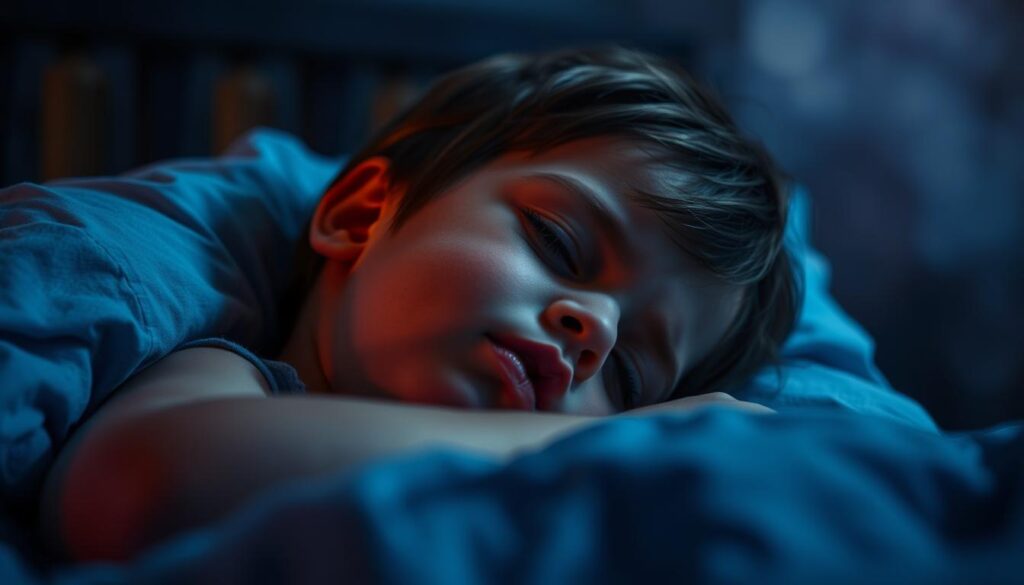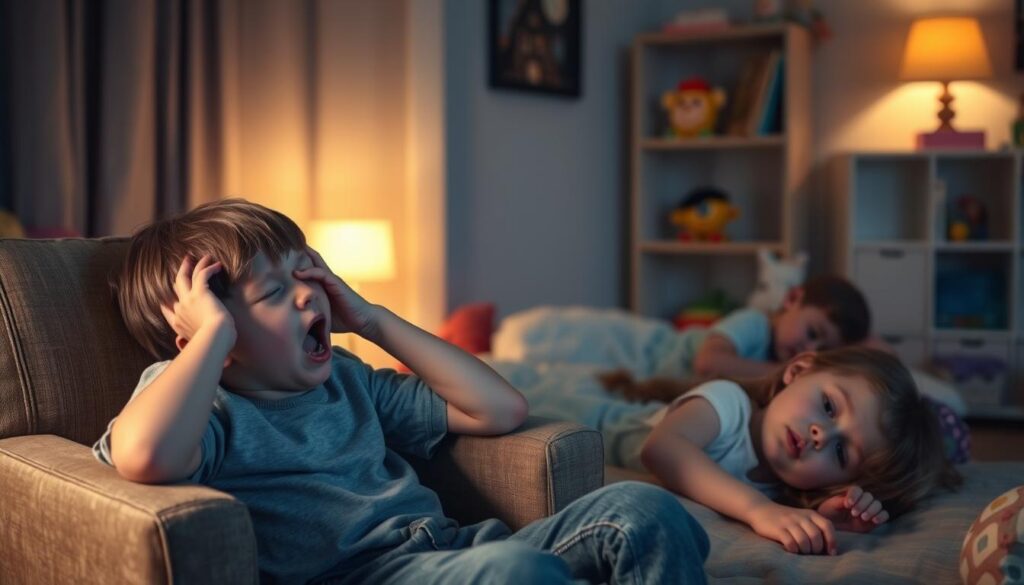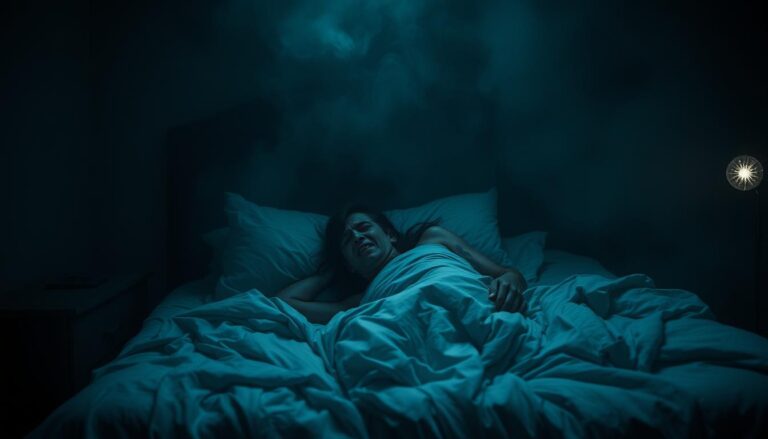
Did you know that during pediatric obstructive sleep apnea, a child’s breathing pauses can last twice as long as a normal breath? This can happen dozens of times each night. These pauses aren’t just minor. They can affect your child’s growth, learning, and heart health if not caught early.
Pediatric sleep apnea warning signs are often easy to miss. They can include loud snoring or sudden mood swings. But many parents don’t notice them because children don’t show symptoms the same way adults do.
Kids with sleep apnea might act out in school or struggle to focus. They might even develop high blood pressure. Catching sleep apnea early can prevent serious problems later on. But to spot the signs, you need to know what to look for.
This guide will help you recognize the red flags. Look out for enlarged tonsils or changes in behavior. Knowing these signs can help protect your child’s health.
Key Takeaways
- Breathing pauses in pediatric sleep apnea can last twice as long as normal breaths, disrupting sleep patterns.
- Enlarged tonsils and obesity are major risk factors, with symptoms varying by age.
- Children often show behavioral issues like hyperactivity instead of daytime sleepiness.
- Untreated cases can lead to heart problems, growth delays, and learning struggles.
- Early pediatric sleep apnea detection improves outcomes and prevents long-term health risks.
Understanding Pediatric Sleep Apnea: What Parents Need to Know
Spotting pediatric sleep disorder symptoms or childhood sleep apnea signs early is key. It helps keep your child healthy. Let’s look at the basics and why acting fast is important.
What Is Pediatric Sleep Apnea?
Obstructive sleep apnea (OSA) happens when airways get blocked during sleep. This stops breathing for short times. It lowers oxygen and messes with sleep cycles.
Central sleep apnea is rarer. It’s when the brain forgets to tell the body to breathe. Both types make kids very tired, even after sleeping a lot.
How Common Is Sleep Apnea in Children?
- About 1-5% of children have OSA, but many don’t get diagnosed.
- More than 80% of kids with OSA have big tonsils or adenoids.
- Being overweight increases risk 3-5 times, and family history 2-3 times.
- Children with Down syndrome are 2-5 times more likely to have it.
Why Early Detection Matters for Your Child’s Health
Not treating OSA can hurt your child’s growth. Studies show it can cause:
- Learning problems and a 20-30% drop in school grades
- Behavior issues like being too active or moody
- Long-term risks like heart problems or growth delays
Getting a diagnosis early through sleep studies (90% accurate) helps. Treatments like surgery or CPAP therapy can fix these problems. If your child snores loudly, gasps, or is tired during the day, see a doctor.
Pediatric Sleep Apnea Warning Signs During Sleep
Spotting signs of sleep apnea in children starts with observing your child’s sleep. Even brief pauses in breathing or sudden gasps could be pediatric sleep apnea red flags. Here’s what to watch for:

- Loud, repetitive snoring that disrupts sleep
- Visible pauses in breathing lasting 10+ seconds
- Gasping, snorting, or choking sounds during rest
- Mouth breathing even when nasal passages are clear
Infants may show different pediatric sleep apnea red flags. Look for:
- Breathing pauses longer than 20 seconds
- Irregular breathing patterns or color changes (bluish skin)
- Awakening due to blocked airways
Arkansas Children’s Hospital reports that 80% of children with enlarged tonsils improve after surgery
| Symptom | What to Do |
|---|---|
| Gasping during sleep | Contact a pediatrician immediately |
| Bedwetting after months of dry nights | Monitor for other symptoms and seek evaluation |
| Excessive sweating without fever | Link to sleep-disordered breathing |
Unusual nighttime sweating or sudden bedwetting after dry periods are also signs of sleep apnea in children. If you hear choking sounds or see breathing pauses, act fast. Arkansas Children’s recommends overnight sleep studies to confirm cases. Early action prevents long-term issues like developmental delays or learning struggles.
Daytime Symptoms That May Indicate Sleep Disordered Breathing
Daytime signs are often overlooked but very important. They help us spot sleep apnea in kids. If your child seems tired even after sleeping well, it might be a sign of children’s sleep apnea symptoms. Catching it early can stop serious health problems later.

Behavioral Changes to Watch For
Look for changes that affect daily life:
- Hyperactivity or restlessness, often mistaken for ADHD
- Unexplained irritability or frequent meltdowns
- Difficulty following simple instructions or staying calm
Academic Performance Concerns
School problems might mean sleep issues:
- Slipping grades or trouble focusing in class
- Complaining about feeling “too tired” to finish homework
- Falling asleep during car rides or sedentary activities
Physical Symptoms During Waking Hours
Notice these signs during the day:
- Morning headaches or frequent throat dryness
- Breathing through the mouth instead of the nose
- Unexplained weight loss or failure to grow as expected
Putting together these clues with nighttime signs gives a clearer picture. If many signs last, talk to your pediatrician about a sleep check. Early action can boost your child’s energy, mood, and health for the future.
Risk Factors and Causes of Sleep Apnea in Children
Knowing what risks your child faces helps find pediatric obstructive sleep apnea indicators early. The main cause is often enlarged tonsils or adenoids blocking airways at night. Kids aged 2–6 are most at risk because their tonsils and adenoids grow bigger.
Being overweight also increases the risk, especially in teens. Extra fat around the neck can make airways narrower.
- Genetic links: Kids with Down syndrome or family history face higher risks.
- Birth defects: Small jaws, cleft palate, or neuromuscular issues like cerebral palsy.
- Other factors: Premature birth, allergies, or frequent sinus infections.

Children who are overweight have a 30-40% higher chance of sleep apnea. Even underweight kids can have narrow airways and symptoms. Families with snoring or sleep disorders should watch for pediatric sleep apnea warning signs.
“Early detection can prevent long-term health impacts like growth delays or heart strain,” says Dr. Maria Lopez, a pediatric sleep specialist.
Regular visits to ENTs or dentists can spot swollen tonsils or jaw issues early. If your child snores loudly or gasps for breath at night, see a doctor right away. Tackling risks like weight or allergies might lessen symptoms before they get worse.
Diagnosis and Treatment Options for Your Child
If your child needs pediatric sleep apnea detection, knowing what to do next is key. Early action can help manage symptoms like snoring or daytime tiredness. These are signs of pediatric sleep disorder symptoms.

When to Contact Your Pediatrician
Call your doctor if your child shows signs like:
- Snoring at least three nights a week
- Gasping for air during sleep
- Bedwetting or frequent nighttime awakenings
What to Expect During a Sleep Study
A sleep study (polysomnogram) monitors:
- Eye movements and brain waves
- Heart rate and blood oxygen levels
- Body movements and breathing patterns
Treatment Approaches for Different Age Groups
| Treatment | Age Group | Effectiveness |
|---|---|---|
| Adenotonsillectomy | 2–12 years | 70–80% improvement |
| CPAP therapy | Any age | 10–20% of cases |
| Oral appliances | Older children | 20–30% efficacy |
| Weight management | Overweight/obese children | 5–10% weight loss reduces symptoms |
Lifestyle Changes That Can Help
Small changes can make a big difference:
- Allergy control: Reduces airway blockages (effective in 30% of cases)
- Sleep positioning: Elevate the head during rest
- Healthy weight goals: Aim for gradual, safe reductions
Work with your pediatrician to find the best solutions for your child. Follow-up sleep studies will show if treatments are working.
Conclusion: Taking Action for Your Child’s Sleep Health
Spotting sleep apnea in kids starts with knowing the signs. If not treated, it can cause serious problems. These include stunted growth, learning delays, or behavioral issues.
Research shows that 70% of children at a healthy weight get better after surgery. But, waiting too long can make things worse. Acting early is crucial for better results.
Trust your instincts if you see snoring, restless sleep, or daytime tiredness. The American Academy of Pediatrics suggests a sleep study for kids with these signs. Even if surgery helps, keep watching closely.
Only 25% of kids fully get better after surgery. Obesity makes it harder, so changing lifestyle is important. It’s not just about breathing; it’s about helping your child reach their full potential.
Good sleep helps with focus, behavior, and growth. Therapies and surgery can fix cognitive delays. If problems don’t go away, see a specialist.
Small steps today can protect your child’s health for the long run. Being aware can change their future. So, act now and stay alert.












